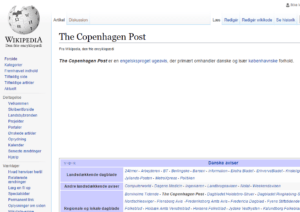News
Danish version of Wikipedia turns 15
This article is more than 8 years old.
Volunteers have generated over 222,000 articles since starting up in February 2002

Hmmm … looks like we need an update (photo: Wikipedia)
The Danish version of the online encyclopedia Wikipedia celebrated its first 15 years of existence today. Since launching on 1 February 2002, the site has generated close to a quarter of a million articles.
The Danish version adds about 1,000 articles every month and now has over 222,000 in total – although it’s a far shout from the English-language version, which consists of around 5.3 million pages.
Nevertheless, the Danish volunteers remain hard at work.
Monthly themes
“At the moment we tend to have monthly themes. In January, it was articles about New York, and in February, it will be the Danish Golden Age,” Villy Fink Isaksen, one of the Danish Wikipedia volunteers, told Version2.
“With a focus we try to fill out the red links. It doesn’t always work, but for New York, for instance, we’ve got about 20 new articles.”
Part of the Danish content stems from translated articles from abroad so users don’t need to rely on English-language versions.
Wikipedia is written and edited by volunteers, but part of the Danish content comes from Danish encyclopedias.
“Regarding Danish culture heritage, we are the primary source other language editions can translate,” said Isaksen.
“That way, we can spread the knowledge of Danish artists or poets, for example. Much of it I’ve copied from Salomonsens Encyclopedia or the first three editions of Dansk Biografisk Encyclopedia. It’s an old language and not everything is that great, so it needs to be cleaned up. I’m not a linguist nerd, but then others can help.”
The work Isaksen and the other volunteers are involved with includes not only writing, but language editing, source insertions, information updates, editing the layout of articles and adding photos to Wikipedia’s image bank.
In principle, Wikipedia welcomes anyone who wants to spend time contributing, but the technical platform does require certain IT competences. Wikipedia-volunteers accordingly hold regular so-called Wikilabs to get newcomers started.
“It’s nice to have it shown to you by someone who is familiar with the system,” said Isaksen.










































